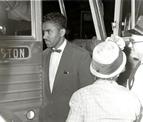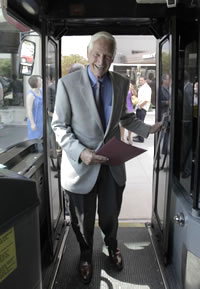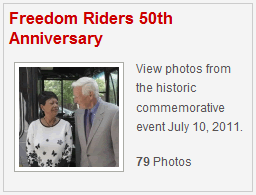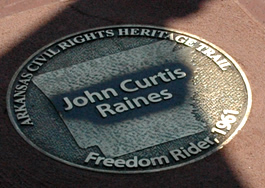Freedom Riders and Activists Welcomed, Honored Fifty Years Later
 When the five Freedom Riders – Rev. Benjamin Elton Cox, Dr. John Curtis Raines, Bliss Ann Malone, Annie Lumpkin and Janet Reinitz – arrived at the old Trailways Bus Station in Little Rock on July 10, 1961, they were met with an agitated crowd of 300 to 400 people and about a dozen police officers who’d come to arrest them.
When the five Freedom Riders – Rev. Benjamin Elton Cox, Dr. John Curtis Raines, Bliss Ann Malone, Annie Lumpkin and Janet Reinitz – arrived at the old Trailways Bus Station in Little Rock on July 10, 1961, they were met with an agitated crowd of 300 to 400 people and about a dozen police officers who’d come to arrest them.
Last Sunday exactly 50 years later, a crowd at least as large gathered on the grounds of the Old State House Museum to honor them.
The ceremony opened with Sen. Joyce Elliott reading a proclamation by Governor Mike Beebe proclaiming July 10, 2011 as “Freedom Riders Day.” Other dignitaries included Dr. Adjoa Aiyetoro, founding director of the UALR Institute on Race and Ethnicity; John Kirk, UALR Donaghey Professor of History and chair; Mark Stodola, mayor of Little Rock; U.S. Representative Tim Griffin; U.S. Senator Mark Pryor; Bruce Moore, Little Rock City Manager; Stephanie S. Street, Executive Director of the Clinton Foundation and keynote speaker Rodney E. Slater, former U.S. Secretary of Transportation.
Edna Cox, widow of Freedom Rider Rev. Benjamin Elton Cox was also among the dignitaries. Rev. Cox, one of the original Freedom Riders who rode busses throughout the country in 1961 testing the federal law restricting segregation on public transportation, passed away last month. During his activism, Rev. Cox was arrested 17 times.
 The only Little Rock Freedom Rider in attendance, Raines, took the stage and said his experience on that long-ago July night changed his life. Admitting that he, a white man, had come from a life of privilege and a place of power. “Being arrested was the best day of my life. It gave me a second education that I otherwise would not have received,” he said. “I found myself outside of power.”
The only Little Rock Freedom Rider in attendance, Raines, took the stage and said his experience on that long-ago July night changed his life. Admitting that he, a white man, had come from a life of privilege and a place of power. “Being arrested was the best day of my life. It gave me a second education that I otherwise would not have received,” he said. “I found myself outside of power.”
The Trailways Bus Station where the Freedom Riders were arrested was located at the corner of Louisiana and Markham Streets in downtown. Now, in its place is a plaque marking the events of that night 50 years ago.
Dr. Kirk was a catalyst for the commemoration. Kirk, author of Beyond Little Rock: The Origins and Legacies of the Central High Crisis and An Epitaph for Little Rock: A Fiftieth Anniversary Retrospective on the Central High Crisis, said that the story of the Freedom Riders is a mere footnote in Little Rock’s history when compared to the Central High Crisis.
“For the Riders to come back 50 years later to be commemorated as heroes can only serve to give a sense of validation that they were on the right side of history,” he said. “To see such a transformation take place within a lifetime must be truly astonishing.”
 The day before the ceremony, the UALR Department of History held a symposium with original members of the Arkansas Student Nonviolent Coordinating Committee (“Arsnick”) at the Mosaic Templars Cultural Center.
The day before the ceremony, the UALR Department of History held a symposium with original members of the Arkansas Student Nonviolent Coordinating Committee (“Arsnick”) at the Mosaic Templars Cultural Center.
Arsnick held sit-in demonstrations in segregated businesses in downtown Little Rock in 1962. Their efforts led to the desegregation of public lunch counters and restrooms a year later.
Arsnick activists in attendance at the symposium included founding member Bill Hansen and Worth Long who told stories of harrassment and physical threats, including being locked in a room by police and gassed with ammonia for their attempts to sit at all-white lunch counters.
More than 350 people attended the symposium, which was free and open to the public. “I think this fantastic attendance reflects a hunger for an exploration of the broader context of the civil rights movement in the state, as well as just how many and how interested people are in discovering those stories,” said Kirk who recently co-edited Arsnick: The Student Nonviolent Coordinating Committee in Arkansas.
With Sunday’s ceremony coming to a close, Aiyetoro pointed to Raines and Mrs. Cox, then to the Arsnick members sitting on the front rows in the audience.
“We are standing on the shoulders of the Freedom Riders and Arsnick,” she said.
 At one point during the commemorative ceremony, Chancellor Anderson announced the creation of the Arkansas Civil Rights Heritage Walk. The sidewalk in front of the Old State House Museum is now inset with ten plaques, one for each Freedom Rider and five Arsnick members – Hansen, Long, Frank James, Frank James Lupper, and Tom Robinson. The Institute plans on adding the names of ten more activists each year until the trail stretches from the Museum to the Clinton Library.
At one point during the commemorative ceremony, Chancellor Anderson announced the creation of the Arkansas Civil Rights Heritage Walk. The sidewalk in front of the Old State House Museum is now inset with ten plaques, one for each Freedom Rider and five Arsnick members – Hansen, Long, Frank James, Frank James Lupper, and Tom Robinson. The Institute plans on adding the names of ten more activists each year until the trail stretches from the Museum to the Clinton Library.
When asked what he took away from the weekend, Kirk said, “For me, one of the most enduring memories of the past weekend is the privilege of being there to see old friends in struggle reunited, the lasting camaraderie and the continuing defiance and insistence that their struggle is not yet over and must go on.”
UALR graduate student of history, Amanda Whitley, took time at the ceremony to reflect on a time long before she was born. “I walked around and people-watched, just to see the expressions on people’s faces,” she said. “Some of those in attendance have seen these changes first hand. I can’t even imagine the experiences that they must have had.”
Visit the Little Rock Freedom Riders website for photos, video, and related stories.